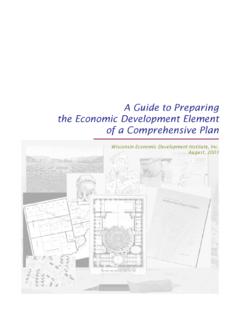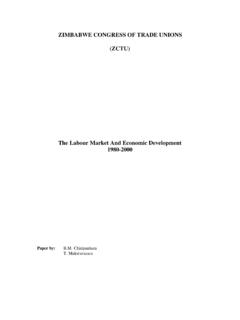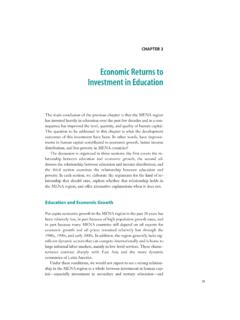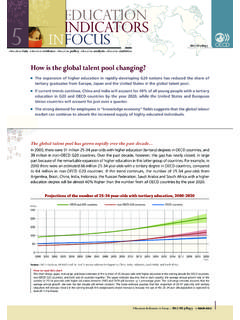Transcription of Industrial development and economic growth: Implications ...
1 295 Industrial development and economic growth : Implications for poverty reduction and incomeinequalityMatleena Kniivil *1. IntroductionThe share of poor people in the global population has declined during recentdecades. According to Chen and Ravallion (2004), one-third of the popula-tion of the world lived in poverty in 1981, whereas the share was 18 per centin 2001. The decline is largely due to rapid economic growth in population-rich countries like China and India. There are, however, remarkable differ-ences between countries and between regions in the developing world. Someregions and countries, notably in East Asia, are rapidly catching up to indus-trialized countries.
2 Others, especially in Sub-Saharan Africa, are lagging farbehind and the share of poor people in the population has even increased insome countries. Industrial development has had an important role in the economicgrowth of countries like China, the Republic of Korea (Korea), TaiwanProvince of China (Taiwan), and Indonesia. Along with accelerated growth ,poverty rates have declined in many countries. Some countries have managedto achieve growth with equity, whereas in others inequality has remainedhigh. In this chapter, the growth stories of seven countries China, India,Korea, Taiwan, Indonesia, Mexico and Brazil are described and main emphasis is on describing their growth processes and strategies, therole of Industrial development , the contribution of a range of policies togrowth performance, and the impact of growth on poverty and incomeinequality.
3 The study begins with a short theoretical discussion of the impactof Industrial development on growth and the impact of growth on povertyand income inequality and then proceeds to the country examples. The finalsection discusses the lessons learnt. 2. The role of structural change in economic growthThe current understanding of economic growth is largely based on the neo-classical growth model developed by Robert Solow (1956). In the Solowmodel, capital accumulation is a major factor contributing to economicgrowth. Productivity growth measured as an increase in output per worker results from increases in the amount of capital per worker, or capital accu-mulation ( Fagerberg 1994).
4 Capital deepening will continue until the* Pellervo economic Research Institute, Helsinki, development for the 21st Centuryeconomy reaches its steady state a point at which net investments grow atthe same rate as the labour force and the capital-labour ratio remains con-stant. The further the economy is below its steady state, the faster it shouldgrow (see Jones 1998). In the steady state, all per capita income growthis due to exogenous technological change. The rate of technological processis assumed to be constant and not impacted by economic incentives. Severalauthors have found that capital and labour actually explain only a fraction ofoutput growth and that allowing for the quality of the labour force (humancapital) only partially reduces the unexplained growth or Solow residual.
5 Endogenous growth theory, initiated by Romer (1986, 1990) and Lucas(1988), focuses on explaining the Solow residual. Technological changebecomes endogenous to the model and is a result of the allocative choices ofeconomic agents (see Aghion and Howitt 1998, Veloso and Soto 2001).Technological progress is driven by R&D activities which in turn are fuelledby private firms aim to profit from inventions. Unlike other productioninputs, ideas and knowledge are nonrivalrous (see Romer 1990). Moreover,new knowledge can augment the productivity of existing knowledge, yield-ing increasing returns to scale. Because of this, the marginal productivity ofcapital does not decline with increasing GDP per capita, and incomes neednot converge across countries.
6 Technological change and innovations are essential sources of structuralchange. In Schumpeter s view, innovations lead to creative destruction , aprocess whereby sectors and firms associated with old technologies declineand new sectors and firms emerge and grow (see Verspagen, 2000). Moreproductive and profitable sectors and firms displace less productive and lessprofitable ones and aggregate productivity in the economy change is thus at the very centre of modern economic on the observation that, beginning with the Industrial Revolution,technological change took place mainly in the manufacturing sector, authorslike Kaldor (1970) and Cornwall (1977) have asserted that the expansion ofthis sector is a driving force for economic growth (see Verspagen, 2000).
7 Moreover, Cornwall (1976, 1977) saw technological change in certain man-ufacturing sectors as a driving force for productivity growth in several (1986) observes that, when overall growth accelerates, man-ufacturing typically leads the way and grows faster than other sectors. At lowincome levels, the share of manufacturing in GDP is, however, low and itsimmediate contribution to aggregate growth minor. When manufacturingincreases its output share often as a response to changes in domesticdemand and in comparative advantage faster sectoral growth noticeablyraises the aggregate growth rates of output and labour productivity. In developed countries, research and development (R&D) activities arethe main driver of technological change.
8 This is not, however, the onlymechanism of technological change. Firms and individual employees learnby doing, increasing output and productivity even if technology or inputs297 Industrial development and economic growthremain unchanged (see Arrow 1962). As R&D activities in developingcountries are relatively limited and countries are far from the technologicalfrontier, international technology diffusion is essential for productivitygrowth. International economic relations, especially international trade butalso foreign direct investment, are important channels of technology transferand increased productivity growth . However, technology diffusion can onlybe efficient if the level of human resources is high enough, incentives fortechnological improvement are strong, and institutions are relatively of the driving forces for structural change is the change in domes-tic and international demand.
9 At relatively low income levels, individualsspend a significant part of their income on food. As income rises, this sharetends to decline, whereas demand for manufactures rises. Similarly, asincome rises further, demand for manufactures increases at diminishing rates,whereas demand for services rises rapidly. Changes in demand will alsochange sectoral employment and output shares and impact the economy slabour productivity. Furthermore, trade has an impact on countries special-ization patterns and on the rate of industrialization or structural changewithin industries. Under an open trade regime, countries tend to specializein the production of commodities for which they have a comparative advan-tage and import commodities which are relatively expensive to producedomestically.
10 Trade openness is also likely to bring foreign investment intothe country. This is often vital, and especially so at early stages of develop-ment. It is also likely to increase productivity as domestic companies are fac-ing external competition. However, the composition of foreign trade matters as well as the open-ness of trade ( Amable, 2000; also, Rodrik in this volume). Moreover, spe-cialization in itself does not necessarily lead to higher growth rates. This ismost evident in the case of developing countries dependent on exports of pri-mary products. As real international prices of non-oil commodities havetrended downward over time and are subject to sizeable short-term fluctua-tions, specialization in primary production seldom promotes sustained eco-nomic growth .

















